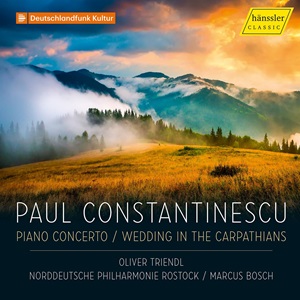
Paul Constantinescu (1909-1963)
Piano Concerto (1952)
Wedding in the Carpathians (1938)
Oliver Treindl (piano)
North German Philharmonic Rostock/Marcus Bosch
rec. 2023, Volkstheater Rostock, Germany
Hänssler Classic HC24014 [53]
Paul Constantinescu, a student of Joseph Marx and Franz Schmidt in Vienna, was a vivid, colour-conscious composer. He wasn’t as striking or – some may say – as blatant as the decade-older Bulgarian, Pancho Vladigerov. As a post-Enescu exemplar of Romanian composition, he was a synthesiser of ancient modes and contemporary folklore, emerging as a balanced exponent of Western and national folk-conscious idioms.
The Piano Concerto of 1952 is a three-movement work cast in a conventional structure. The dramatic opening ushers in a slow piano statement that soon speeds up. There’s plenty of scurry, a brief fugal feint – at only three minutes in – and plenty of fluidity. At its best it has an exciting, fluid-filmic sense. At its worst, it’s a lot of hot air. The slow movement seems to be based on the native Doina, the folk vocal monologue, but as refracted through the central movement of Ravel’s Piano Concerto. However, the melancholy nature of the song is fully established and the music resolves admirably. The folk-like nimble finale has vitality and energy, with a good balance between the piano and orchestral forces. It’s an attractive work though uneven but very finely played by Oliver Treindl, who is always in demand for ventures of this sort – you can hear why – and the North German Philharmonic Rostock under Marcus Bosch.
Wedding in the Carpathians sounds like the title of an exotic Pathé newsreel, but is a ‘choreographic poem in one-act’ composed in 1938 and subtitled ‘Romanian Wedding Ballet’. It was premiered the following year in a performance directed by George Georgescu – surely there’s a box set of his recordings for an intrepid record company with the rights to release it? Though the plot may remind one of Stravinsky’s Les Noces, musically speaking its genesis is in an ethnological research project a decade earlier into a remote area in north-east Romania. That aligns it much closer to the earlier research work of Kodály and Bartók in Hungary and Janáček in Moravia. The ballet is colourfully orchestrated and there are brief scenes in which a plethora of detail and dance can be encountered. The music alternates between brassy fanfares, tangy sonorities, cocky little dances, jagged pesante elements, and much zest. Native dances such as the Hora are here, as is a role for village fiddler which generates a swirling, teaky percussive intensity – the only concession to Stravinsky I could really detect. A jubilant dance ends the piece with vigour.
Constantinescu died young, at only 54. The works here, composed either side of the War, reflect two sides to his compositional nature, the Concerto more Western-leaning though with some florid ethnic elements, and the ballet a more stylized but necessarily blatant example of national folkloric influence.
The documentation is helpful and the recorded sound is warmly supportive of the performances. Let’s hope we’ll hear more of the composer’s music from this source – the two symphonies and the Violin Concerto, for example.
Jonathan Woolf
Buying this recording via a link below generates revenue for MWI and helps us keep free access to the site




















